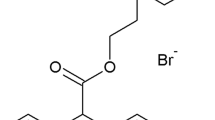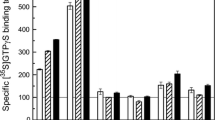Abstract
The binding characteristics of pirenzepine and oxomemazine to muscarinic receptor were studied to evaluate the selectivity of oxomemazine for the muscarinic receptor subtypes in rat cerebral microsomes. Equilibrium dissociation constant (KD) of (−)-[3H]quinuclidinyl benzilate([3H]QNB) determined from saturation isotherms was 64 pM. Analysis of the pirenzepine inhibition curve of [3H]QNB binding to cerebral microsome indicated the presence of two receptor subtypes with high (Ki=16 nM, M1 receptor) and low (Ki=400 nM, M3 receptor) affinity for pirenzepine. Oxomemazine also identified two receptor subtypes with about 20-fold difference in the affinity for high (Ki=84nM, OH receptor) and low (Ki=1.65 μM, OL receptor) affinity sites. The percentage populations of M1 and M3 receptors to the total receptors were 61∶39, and those of OH and OL receptors 39∶61, respectively. Both pirenzepine and oxomemazine increased the KD value for [3H]QNB without affecting the binding site concentrations and Hill coefficient for the [3H]QNB binding, Oxomemazine had a 10-fold higher affinity at M1 receptors than at M3 receptors, and pirenzepine a 8-fold higher affinity at OH receptors than at OL receptors. Analysis of the shallow competition binding curves of oxomemazine for M1 receptors and pirenzepine for OL receptors yielded that 69% of M1 receptors were of OH receptors and the remaining 31% of OL receptors, and that 29% of OL receptors were of M1 receptors and 71% of M3 receptors. However, M3 for oxomemazine and OH for pirenzepine were composed of a uniform population. These results suggest that oxomemazine could be classified as a selective drug for M1 receptors and also demonstrate that rat cerebral microsomes contain three different subtypes of M1, M3 and the other site which is different from M1, M2 and M3 receptors.
Similar content being viewed by others
References Cited
Ambre, J. J., Bennett, D. R., Cranston, J. W., Dickinson, B. D., Evans, R. M., Glade, M. J., Kosman, M. E., Lampe, K. F., McCann, M. A., Pang, D. C., Proudfit, C. M., Rapoza, N. P., Ratko, T. A., Seidenfeld, J., Smith, S. J. and Weaver, R., Drug evaluations annual 1991.American Medical Association, pp. 1601–1604 (1991).
Barlow, R. B., Berry, K. J., Glenton, P. A. M., Nikolaou, N. M. and Soh, K. S., A comparison of affinity constants for muscarinic-sensitive acetylcholine receptors in guinea-pig atrial pacemaker cells at 29°C. and ileum at 37°C.Br. J. Pharmacol., 58, 613–620 (1976).
Barlow, R. B., Burston, K. N. and Vis, A., Three types of muscarinic receptors?Br. J. Pharmacol., 68, 141–142 (1980).
Berrie, C. P., Birdsall, N. J. M., Burgen, A. S. V. and Hulme, E. C., The binding of muscarinic receptors in the lacrimal gland: Comparision with the cerebral cortex and myocardium.Br. J. Pharmacol., 78, 66P (1983).
Birdsall, N. J. M. and Hulme, E. C., Biochemical studies on muscarinic acetylcholine receptors.J. Neurochem., 27, 7–16 (1976).
Bolden, C., Cusack, B. and Richelson, E., Clozapine is a potent and selective muscarinic antagonist at the five cloned human muscarinic cholinergic receptors expressed in CHO-K1 cells.Eur. J. Pharmacol., 192, 205–206 (1991).
Bolden, C., Cusack, B. and Richelson, E., Antagonism by antimuscarinic and neuroleptic compounds at the five cloned human muscarinic cholinergic receptors expressed in Chinese hamster ovary cells.J. Pharmacol. Exp. Ther., 260, 576–580 (1992).
Bonner, T. I., The molecular basis of muscarinic receptor density.Trends Neurol. Sci., 12, 148–151 (1989).
Bonner, T. I., Buckley, N. J., Young, A. C. and Brann, M. R., Identification of a family of muscarinic acetylcholine receptor genes.Science, 237, 527–532 (1987).
Bonner, T. I., Young, A. C., Brann, M. R. and Buckley, N. J., Cloning and expression of the human and rat M5 muscarinic acetylcholine receptor genes.Neuron, 1, 403–410 (1988).
Brown, D. A., Forward, A. and Marsh, S., Antagonist discrimination between ganglionic and ileal muscarinic receptors.Br. J. Pharmacol., 71, 362–364 (1980).
Buckley, N. J., Bonner, T. I. and Brann, M. R., Localization of a family of muscarinic receptor mRNAs in rat brain.J. Neurosci., 8, 4646–4652 (1988).
Buckley, N. J., Bonner, T. I., Buckley, C. M. and Brann, M. R., Antagonist binding properties of five cloned muscarinic receptors expressed in CHO-K1 cells.Mol. Pharmacol., 35, 469–476 (1989).
Cheng, Y. C. and Prusoff, W. H., Relationship between the inhibition constant (Ki) and the concentration of inhibitor which causes 50 percent inhibition (IC50) of an enzymatic reaction.Biochem. Pharmacol., 22, 3099–3108 (1973).
Dauphin, F. and Hamel, E., Identification of multiple muscarinic binding site subtypes in cat and human cerebral vasculature.J. Pharmacol. Exp. Ther., 260, 660–667 (1992).
Doods, H. N., Mathy, M. J., Davidesko, D., Van, Charldorp, K. J., De, Jonge, A. and Van, Zwieten, P. A., Selectivity of muscarinic antagonists in radioligand and in vivo experiments for the putative M1, M2 and M3 receptors.J. Pharmacol. Exp. Ther., 242, 257–262 (1987).
Delmendo, R. E., Michel, A. D. and Whiting, R. L., Affinity of muscarinic receptor antagonists for three putative muscarinic receptor binding sites.Br. J. Pharmacol., 96, 457–464 (1989).
Dörje, F., Wess, J., Lambrecht, G., Tacke, R., Mutschler, E. and Brann, M. R., Antagonist binding profiles of five cloned human muscarinic receptor subtypes.J. Pharmacol. Exp. Ther., 256, 727–733 (1991).
El-Fakahany, E. E., Cioffi, C. L., Abdellatif, M. M. and Miller, M. M., Competitive interaction of pirenzepine with rat brain muscarinic acetylcholine receptors.Eur. J. Pharmacol., 131, 237–247 (1986).
Giachetti, A., Micheletti, R. and Montagna, E., Cardioselective profile of AF-DX 116, a muscarinic M2 receptor antagonist.Life Sci., 38, 1663–1672 (1986).
Giraldo, E., Hammer, R. and Ladinsky, H., Distribution of muscarinic receptor subtypes in rat brain as determined in binding studies with AF-DX 116 and pirenzepine.Life Sci., 40, 833–840 (1987).
Goyal, R. K. and Rattan, S., Neurohumoral, hormonal, and drug receptors for the lower esophageal sphincter.Gastroenterology, 74, 598–618 (1978).
Hammer, R., Muscarinic receptors in the stomach.Scand. J. Gastroenterol., 15 (Suppl. 66), 5–11 (1980).
Hammer, R., Berrie, C. P., Birdsall, N. J. M., Burgen, A. S. V. and Hulme, E. C., Pirenzepine distinguishes between different subclasses of muscarinic receptors.Nature (Lond.), 283, 90–92 (1980).
Hammer, R. and Giachetti, A., Muscarinic receptor subtypes: M1 and M2 biochemical and functional characterization.Life. Sci., 31, 2991–2998 (1982).
Hammer, R. and Giachetti, A., Selective muscarinic receptor antagonists.Trends Pharmacol. Sci., 5, 18–20 (1984).
Hammer, R., Giraldo, E., Schiavi, G. B., Monferini, E. and Ladinsky, H., Binding profile of a novel cardioselective muscarinic receptor antagonist, AF-DX 116, to membrane of peripheral tissues and brain in the rat.Life Sci., 38, 1653–1662 (1986).
Hirschowitz, B. I. R., Hammer, R., Giachetti, A., Kierns, J. J. and Levine, R. R., Subtypes of muscarinic receptors.Trends Pharmacol. Sci., 5 (suppl.), pp. VII (1984).
Kloog, Y., Egozi, Y. and Sokolovskey, M., Characterization of muscarinic acetylcholine receptors from mouse brain: evidence for regional heterogeneity and isomerization.Mol. Pharmacol., 15, 545–548 (1979).
Lazareno, S. and Roberts, F. F., Functional and binding studies with muscarinic M2 subtype selective antagonists.Br. J. Pharmacol., 98, 309–317 (1989).
Lee, S. W., Park, Y. J., Park, I. S. and Lee, J. S., Interaction of antihistaminics with muscarinic receptor (II): Action on the cerebral muscarinic M1 receptor.Yakhak Hoeji, 34(4), 224–237 (1990).
Lee, S. W. and Kim, J. G., Binding profiles of oxomemazine to the muscarinic receptor subtypes.Korean J. Pharmacol., 30, 49–57 (1994).
Lowry, O. H., Rosebrough, N. J., Farr, A. L. and Randall, R. J., Protein measurement with the Folin phenol reagent.J. Biol. Chem., 193, 265–275 (1951).
Luthin, G. R. and Wolfe, B. B., Comparison of [3H] pirenzepine and [3H]quinuclidinylbenzilate binding to muscarinic cholinergic receptors in rat brain.J. Pharmacol. Exp. Ther., 228, 648–655 (1984).
Micheletti, R., Montagna, E. and Giachetti, A., AF-DX 116, a cardioselective muscarinic antagonist.J. Pharmacol. Exp. Ther., 241, 628–634 (1987).
Michel, A. D. and Whiting, R. L., Methoctramine reveals heterogeneity of M2 muscarinic receptors in longitudinal ileal smooth muscle membranes.Eur. J. Pharmacol., 145, 305–311 (1988).
Munson, P. J. and Rodbard, D., LIGAND: A versitile computerized approach for characterization of ligand-binding systems.Anal. Biochem., 107, 220–239 (1980).
Peralta, E. G., Ashkenazi, A., Winslow, J. W., Smith, D. H., Ramachandran, J. and Caron, D., Distinct primary structures, ligand binding properties and tissue specific expression of four human muscarinic acetylcholine receptors.EMBO J., 6, 3923–3929 (1987).
Scatchard, G., The attractions of proteins for small molecules and ions.Ann. N. Y. Acad. Sci., 51, 660–672 (1949).
Watson, M., Yamamura, H. I. and Roeske, W. R., A unique regulatory profile and regional distribution of [3H]pirenzepine binding in the rat provide evidence for distinct M1 and M2 muscarinic receptor subtypes.Life Sci., 32, 3001–3011 (1983).
Wess, J., Lambrecht, G., Mutschler, E., Brann, M. R. and Dörje, F., Selectivity profile of the novel muscarinic antagonist UH-AH 37 determined by the use of cloned receptors and isolated tissue preparations.Br. J. Pharmacol., 102, 246–250 (1991).
Author information
Authors and Affiliations
Rights and permissions
About this article
Cite this article
Lee, S.W., Woo, C.W. & Kim, J.G. Selectivity of oxomemazine for the M1 muscarinic receptors. Arch. Pharm. Res. 17, 443–451 (1994). https://doi.org/10.1007/BF02979123
Received:
Issue Date:
DOI: https://doi.org/10.1007/BF02979123




